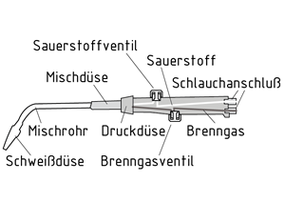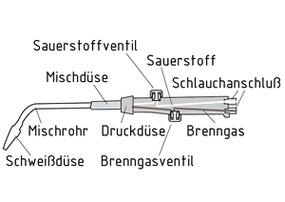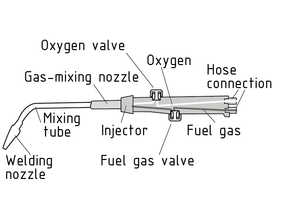
Choose one
or multiple languages
0,1,1
- German
- English
- Chinese
- Spanish
Gas welding

Gas welding is also called autogenous welding and involves heating metallic workpieces using a gas torch with a flame produced from a Welding gas mixture through combustion. In most cases, workpieces are bonded with a filler material (welding wire). Acetylene or some other fuel gas is burnt with exactly the amount of oxygen required to maintain a flame at a temperature of approx. 3,200°C. This creates a barrier between the weld pool and the atmosphere.
Autogenous welding is mainly used for non-alloyed or low-alloy Steel materials, for cast Iron and non-ferrous metals, and for sheet metal up to six millimetres thick. In manual production operations, it is particularly common in Joint welding (pipework, installations).
Benefits include low investment costs, excellent handling and effective gap bridging. Low welding speeds and poor deposition efficiencies are two drawbacks in industrial production. The high heat input also causes significant component distortion.
Gasschmelzschweißen

Das Gasschmelzschweißen wird auch als Autogenschweißen bezeichnet. Dabei werden metallische Werkstücke mit einer Flamme erhitzt, die ein Gasbrenner aus einem Schweißgasgemisch durch Verbrennung erzeugt. Die Werkstücke werden meist mit einem Zusatzwerkstoff (Schweißdraht) verbunden. Für die etwa 3.200 °Celsius heiße Flamme wird Acetylen oder ein anderes Brenngas mit der exakt dafür benötigten Menge Sauerstoff verbrannt. Dadurch ist das Schweißbad zur Atmosphäre hin abgeschirmt.
Autogenschweißen wird vor allem bei unlegierten oder niedriglegierten Stahlwerkstoffen, bei Gusseisen und Nichteisenmetallen sowie bei bis zu sechs Millimeter dicken Blechen eingesetzt. Es ist in der manuellen Fertigung vor allem beim Verbindungsschweißen (Rohrleitungen, Installationen) üblich.
Vorteile sind niedrige Investitionskosten, gute Handhabung und Spaltüberbrückung. Nachteile für die industrielle Fertigung sind geringe Schweißgeschwindigkeiten und Abschmelzleistungen. Hohe Wärmeeinbringung bedingt zudem einen starken Verzug im Bauteil.
气焊

气焊也被称为自熔接,是指焊炬通过燃烧焊接混合气体产生火焰来加热金属工件。在大多数情况下,工件与填料(焊丝)接合。乙炔或一些其它燃料气体和合适比例的氧气一起燃烧,恰好使火焰温度维持在 3200℃ 左右。由此创建焊接熔池与大气之间的屏障。 自熔接主要用于非合金或低合金钢材料、铸铁和有色金属,以及厚达六个毫米的金属板材。在手工生产操作中,在接头焊接(管道、装置)中尤为常用。 其优点包括较低的投资成本、出色的可操控性和有效的差距桥接。但是在工业生产中的两个缺点是焊接速度低和焊接效率差。高热量输入也会导致部件显著畸变。
焊炬
近义词
自熔接
Soldadura a gas

La soldadura a gas también se llama soldadura autógena e involucra el calentamiento de piezas de trabajo metálicas mediante un soplete de gas con una llama producida por la mezcla de gas de soldadura mediante combustión. En la mayoría de los casos, las piezas de trabajo se adhieren con un material de relleno (alambre de soldadura). Se quema acetileno o algún otro gas combustible con la cantidad exacta de oxígeno requerido para mantener una flama a una temperatura aproximada de 3,200 °C. Esto crea una barrera entre el baño de soldadura y la atmósfera.
La soldadura autógena se usa principalmente para materiales de acero sin aleación o de baja aleación, para acero vaciado y metales no ferrosos y para láminas de hasta seis milímetros de espesor. En las operaciones de producción manual, es particularmente común en las soldaduras de unión (tuberías, instalaciones).
Los beneficios incluyen bajos costos de inversión, excelente manejo y puenteo de espaciamiento efectivo. Las bajas velocidades de soldadura y la mala eficiencia de deposición son dos desventajas en la producción industrial. La alta entrada de calor también causa una distorsión significativa del componente.
Soplete de soldadura
